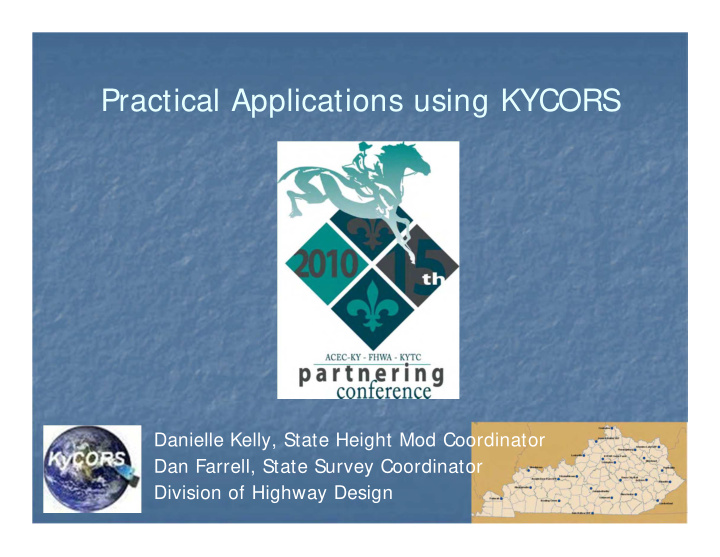



Practical Applications using KYCORS Danielle Kelly, State Height Mod Coordinator Dan Farrell, State Survey Coordinator Division of Highway Design
National CORS Network CORS 1466 National CORS August 3, 2010
Why CORS? Need for increasingly precise information. Declining I nfrastructure
Passive Monuments – Declining Infrastructure
Active Monuments - CORS The National Geodetic Survey’s (NGS) Continuously Operated Reference Stations (CORS) system is an active system of monumentation that provides high accuracy GNSS data. + /-2cm Horizontally and + /-4 cm Vertically
KYCORS Consists of 22 real time GPS stations throughout Kentucky. Eight additional stations planned. 13 Stations part of NGS CORS network. Real time data available to anyone at NO cost.
KYCORS - Current RTK Data Streams Single Base Station Mode: Standard RTK using RTCM 3.2/2.3 or CMR+ . User has ability to pick and choose base station. Currently Anonymous access but will require login & password as of January 2011.
KYCORS - Current RTK Data Streams Network Solution: Network solution available in CMR+ , RTCM 3.2 and 2.3. Requires user to have login & password.
KYCORS - Baselines
Benefits of using CORS CORS replace need for setting up base station Can use NGS OPUS web site or to post process CORS enables differential GPS positioning for post-processing with accuracies from 1 to 10 centimeters, or better. Users need deploy only one GPS receiver and obtain corresponding CORS data over the Internet. Can use KYCORS web site to download data for postprocessing Can get real time corrections from single base station or use VRS to get network solution
Road Planning & Design Aerial Survey/Photogrammetry CORS replacing need for survey crew to set up base stations in vicinity of flight corridor Mapping Assets - roads, buildings, water pipes and power lines Topography Existing Terrain Models Hydrography
Road Construction Grade Checks Proposed & Existing Models loaded Volume Measurements Check as-builts against proposed digital terrain models
Machine control Model generated from digital plans Topo confirmed using rovers/total stations Model used to control the position of each tip of the grader or dozer blade - compares it to the design elevation to compute cut or fill to grade. The cut/fill data is used to drive the valves for automatic blade control or is passed to in-cab lightbars that provide visual guidance to the operator.
Monitoring Monitoring motion in dams & bridges Monitoring Software computes positions based on simultaneous observations from multiple points. The approach keeps the ppm-error components very small and the operators receive a precise, continuous view of what is happening at each sensor. The software “learns” the normal behavior of a monitoring point and creates a model of its typical or expected movement. When observed motion goes beyond what is expected, system alerts operators. Post-processing engine computes position changes with precision of 1 mm (1/25 in).
Mining Relatively small area of visible sky and deep pits make it difficult to receive signals CORS set up around mine Base data is most commonly transmitted from base station to rover via UHF radio UHF generally good only where a clear line of sight exists between the transmitter and receiver VHF radio signals are much less reliant on line of sight and less affected by obstacles a mobile repeater box with VHF antenna, data radio to receive the VHF signal and convert it back to UHF, radio modem to transmit the UHF signal to the rover radio modem can be configured to transmit at a power level (2 W, 15 W or 25 W) to suit the distance to the rover
Other Applications Precision agriculture Machine Control – application model Increasing accuracy in spreading seed, fertilizer & pesticides Irrigation tiles Replacing leveling for drainage grading Large Building Sites One reference system – provides seamless project data integrity and communication
www.kycors.com
Questions?
Recommend
More recommend